These vegan gingerbread cookies are not only wonderfully soft, chewy, and perfectly spiced but are made with almond flour and naturally sweetened with coconut sugar. The result? Paleo-friendly, refined-sugar-free, grain-free, dairy-free, and gluten-free gingerbread cookies this Christmas!

Soft, Chewy Gluten-Free Gingerbread Cookies
I’m not sure why it’s taken me so long to share my favorite vegan gingerbread cookies (especially having shared gingerbread cake and gingerbread tiramisu), but they’re finally here. These gluten-free, paleo, almond flour gingerbread cookies are incredibly friendly to dietary restrictions and are slightly crisp with a soft, chewy, and perfectly spiced middle!
Along with the traditional spices and sticky molasses that give this vegan gingerbread recipe the signature gingerbread flavor, these cookies are made primarily of pantry staples and wholesome, plant-based ingredients like almond flour, unrefined coconut sugar, and coconut oil. By using almond flour, these gluten-free gingerbread cookies ditch the ‘empty calories’ in regular cookies for a protein-dense, highly nutritious, and healthy nutty base.
Even better, this dough requires just one bowl and a few minutes to prepare before chilling, cutting, and baking (making your house smell divine!). Once baked and chilled, get the entire household involved with the gingerbread decorations (while sipping on big mugs of hot chocolate). There’s no better way to get in the Christmas spirit!
Best of all, you can prepare these in advance and even post them to family and friends this holiday season! Perhaps even create an entire vegan Christmas cookies gift box with cinnamon star cookies (Zimtsterne), almond thumbprint cookies, snickerdoodles, and German hazelnut cookies!

The Ingredients
Almond flour gingerbread cookies
- Almond flour: Use fine blanched almond flour or make your own by grinding blanched almonds in a coffee/spice grinder (though, it won’t be as fine). Avoid almond meal, as it will make the cookies mealy.
- Tapioca flour: Other starches (i.e., cornstarch/ arrowroot) will likely also work. Don’t skip this, as it’s needed for the perfect texture and works as a binder within these egg-free gingerbread cookies.
- Coconut sugar: It tastes similar to brown sugar but is Paleo-friendly, with a lower GI. Though, brown sugar or golden monk fruit sweetener may also work. Although I haven’t tried the latter, so I can’t guarantee results.
- Baking soda: To provide the correct texture to these gingerbread cookies.
- Molasses: Use unsulphured blackstrap molasses, though dark molasses should work for a slightly ‘lighter’ flavor in the molasses cookies. You can technically substitute it for maple syrup, but I don’t recommend it unless you HAVE to.
- Coconut oil: Alternatively, vegan butter may work, but the softness of these dairy-free gingerbread cookies may vary.
- Spices: You’ll need ground cinnamon, ground ginger, ground nutmeg, ground cloves, and a pinch of salt for this vegan gingerbread cookie recipe.
- Cold water: For extra flavor, use orange juice.
Glaze (optional)
- Powdered sugar: Use either powdered sugar or sugar-free powdered Erythritol
- Water: Adjust the amount if needed to achieve the correct consistency. Orange juice will also work.
Optional add-ins & Recipe Variations
- Vanilla extract: A small splash of natural vanilla will add extra flavor to the vegan gingerbread cookies.
- Citrus zest: 1-2 tsp of orange and/or lemon zest will delicately scent these paleo gingerbread cookies with a bright citrus flavor.
- Chocolate gingerbread: I haven’t tried this (yet), but I imagine swapping out some almond flour for 2-3 tbsp cocoa powder would work.
Gingerbread decorations
- Shredded coconut: This can help to mimic snow when decorating your cookies (especially great when making house-shaped cookies).
- Vegan sprinkles
- Mini chocolate chips: Use keto/paleo chocolate if necessary
- Natural food coloring: For the glaze
- Cream cheese frosting: Instead of the simple glaze, combine plain vegan cream cheese with powdered sugar/ Erythritol.
Please read the recipe card below for the full ingredients list, measurements, complete recipe method, and nutritional information.
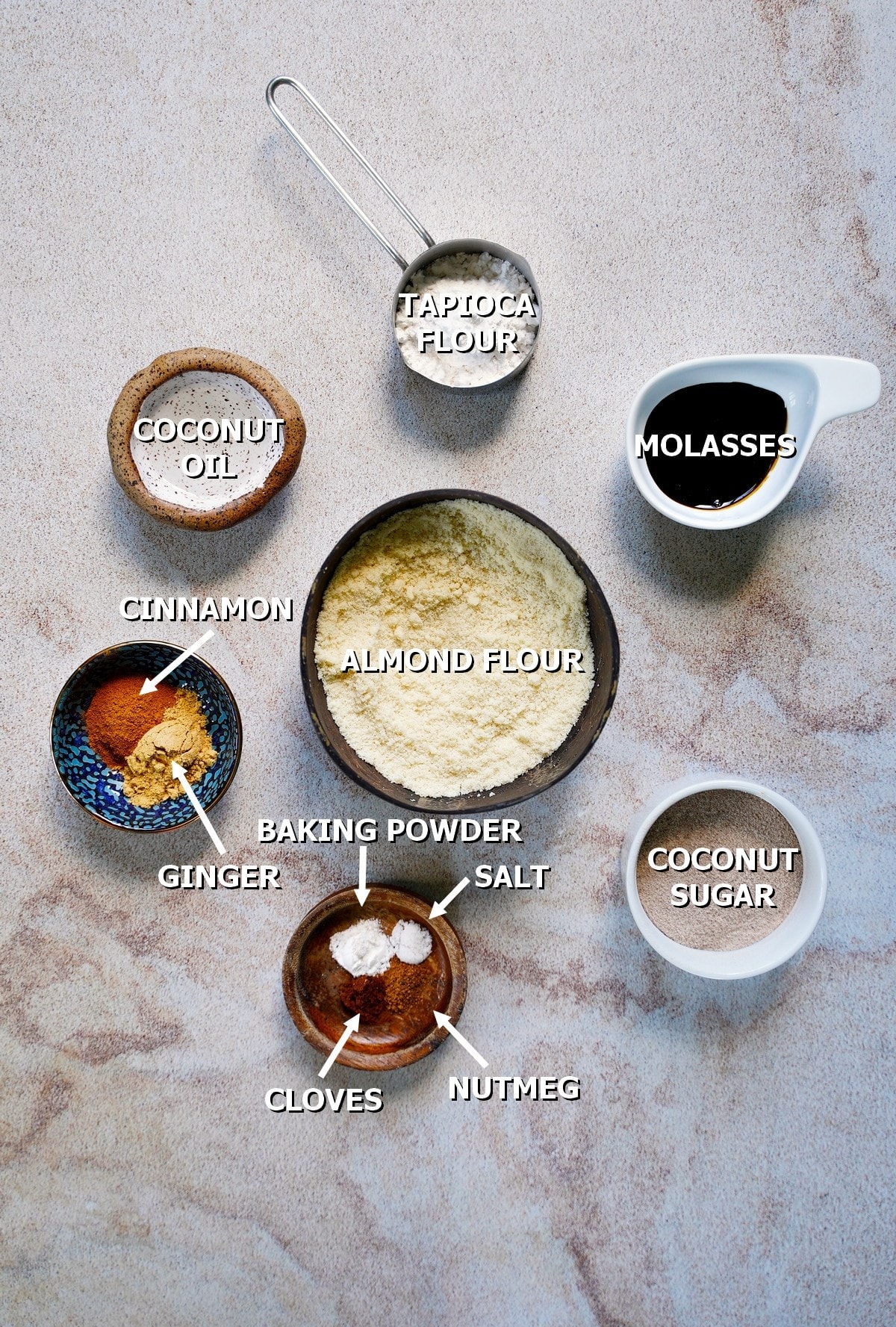
How to Make Vegan Gingerbread Cookies?
Step 1: Prepare the almond flour gingerbread cookie dough
- First, add all the dry ingredients to a large bowl and stir with a wooden spoon.
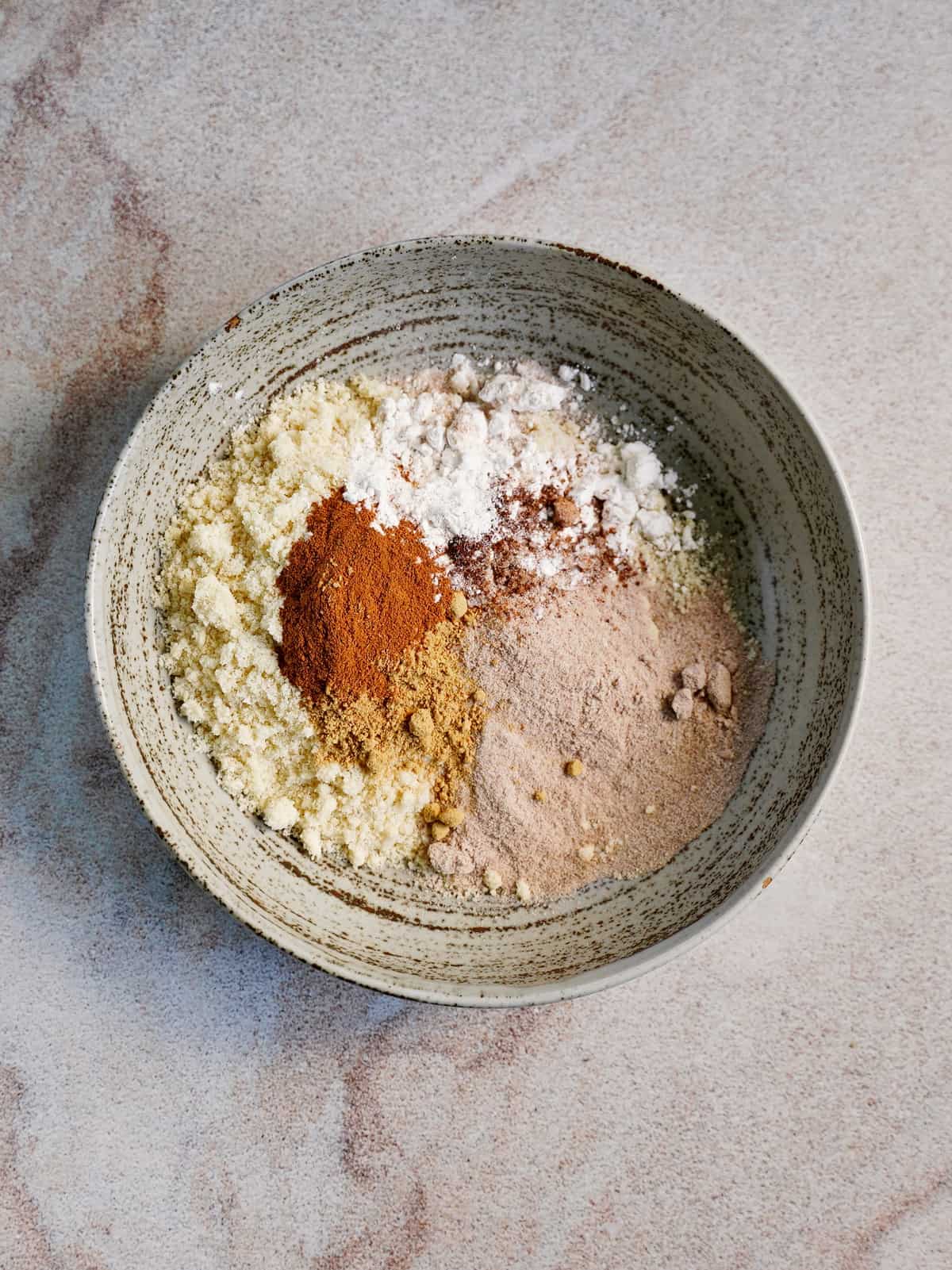
- Then, pour in the wet ingredients (starting with 1 tbsp cold water), and mix again. Knead with your hands until a dough forms (or use a food processor).
If the dough is too dry, add more water (or coconut oil), a teaspoon at a time. If it’s slightly too wet, add more almond flour. But note that almond flour cookie dough is typically a little sticky.
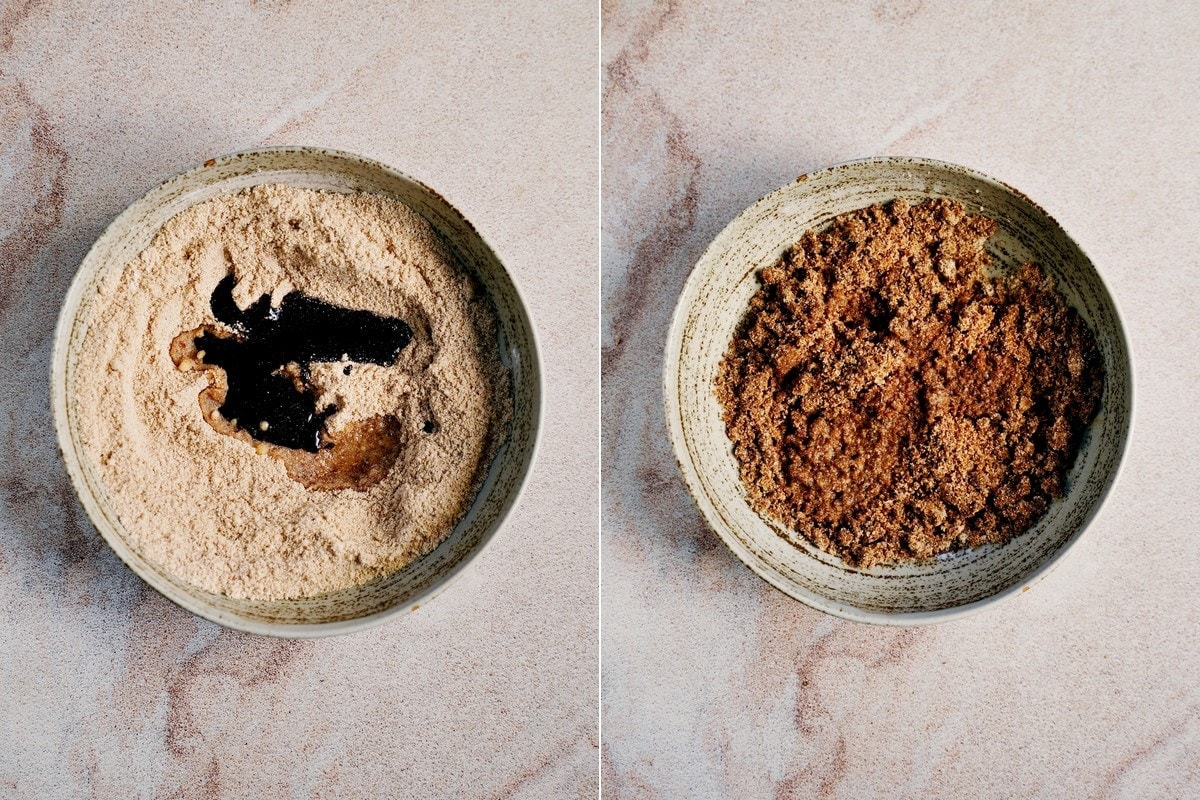
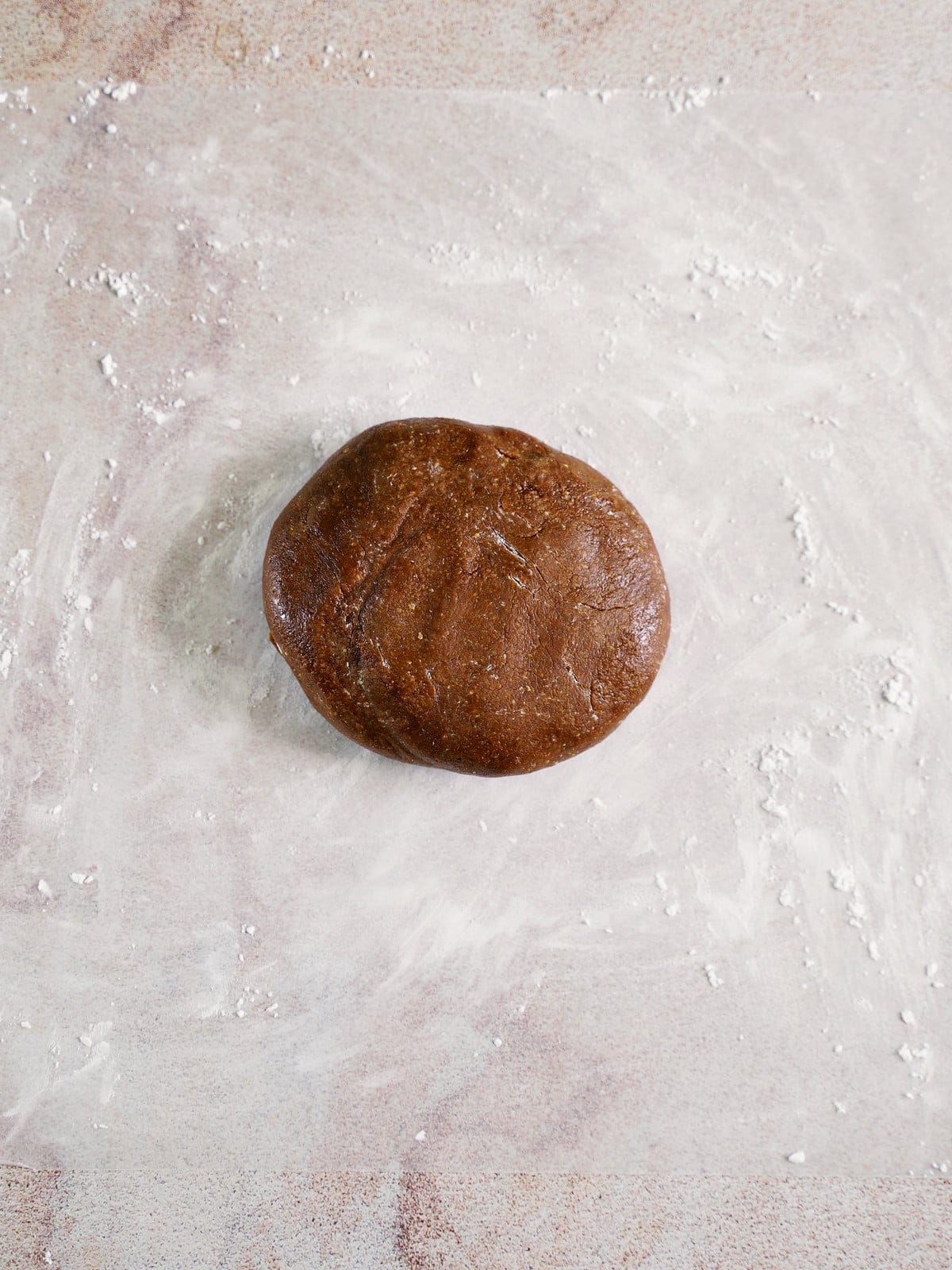
- Next, wrap the dough into cling film and chill it in the fridge for 20-30 minutes.
Step 2: Roll the dough
- Place the chilled dough between 2 layers of wax paper (or parchment paper) and roll it out with a rolling pin until 0.6-0.7 cm thick (1/4- inch). Then preheat the oven to 350F/175C and line a baking sheet with parchment paper.
- Next, use your favorite cookie cutters (gingerbread men, stars, houses, rounds, etc.) to cut out the cookies. Then re-roll and cut the scraps.
Dip the cutter in a small bowl of powdered sugar/tapioca flour between cuts to stop the dough from sticking.
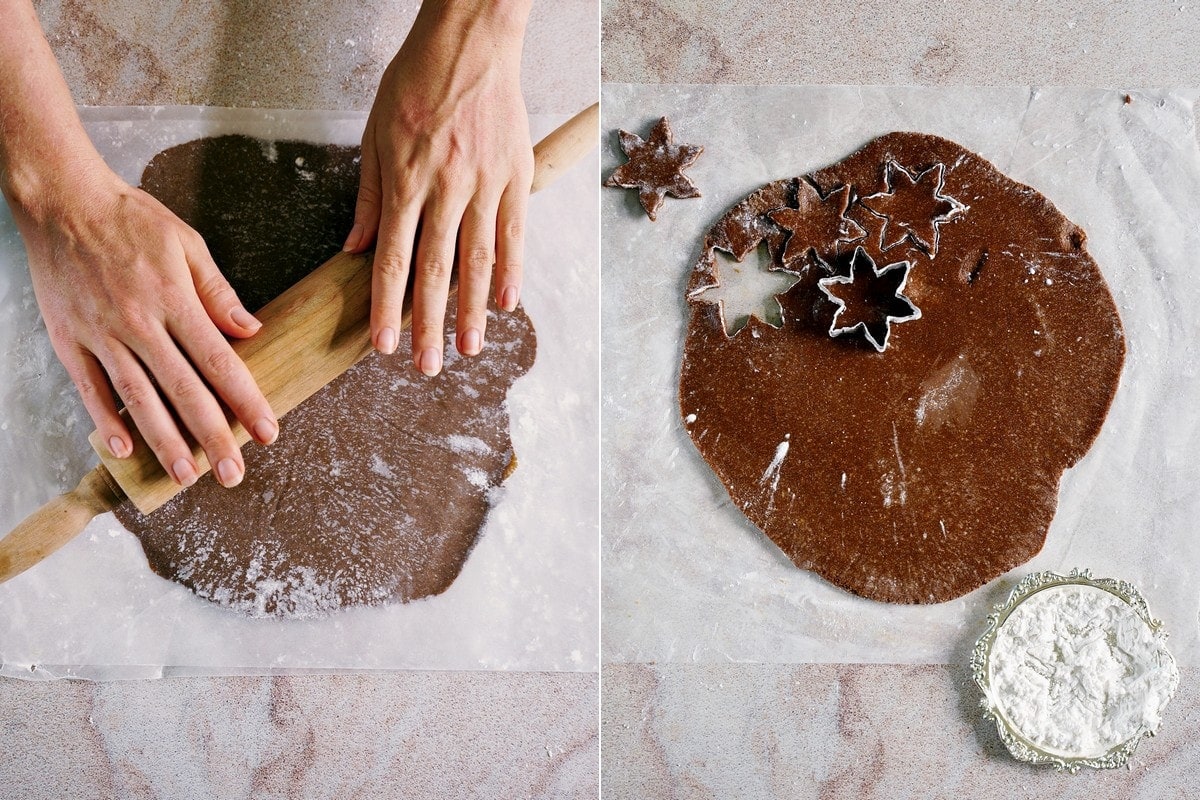
Step 3: Bake the vegan gingerbread cookies
- Place the cookies on the baking tray with 1-inch space between them (use a spatula to do this to avoid squashing the shapes).
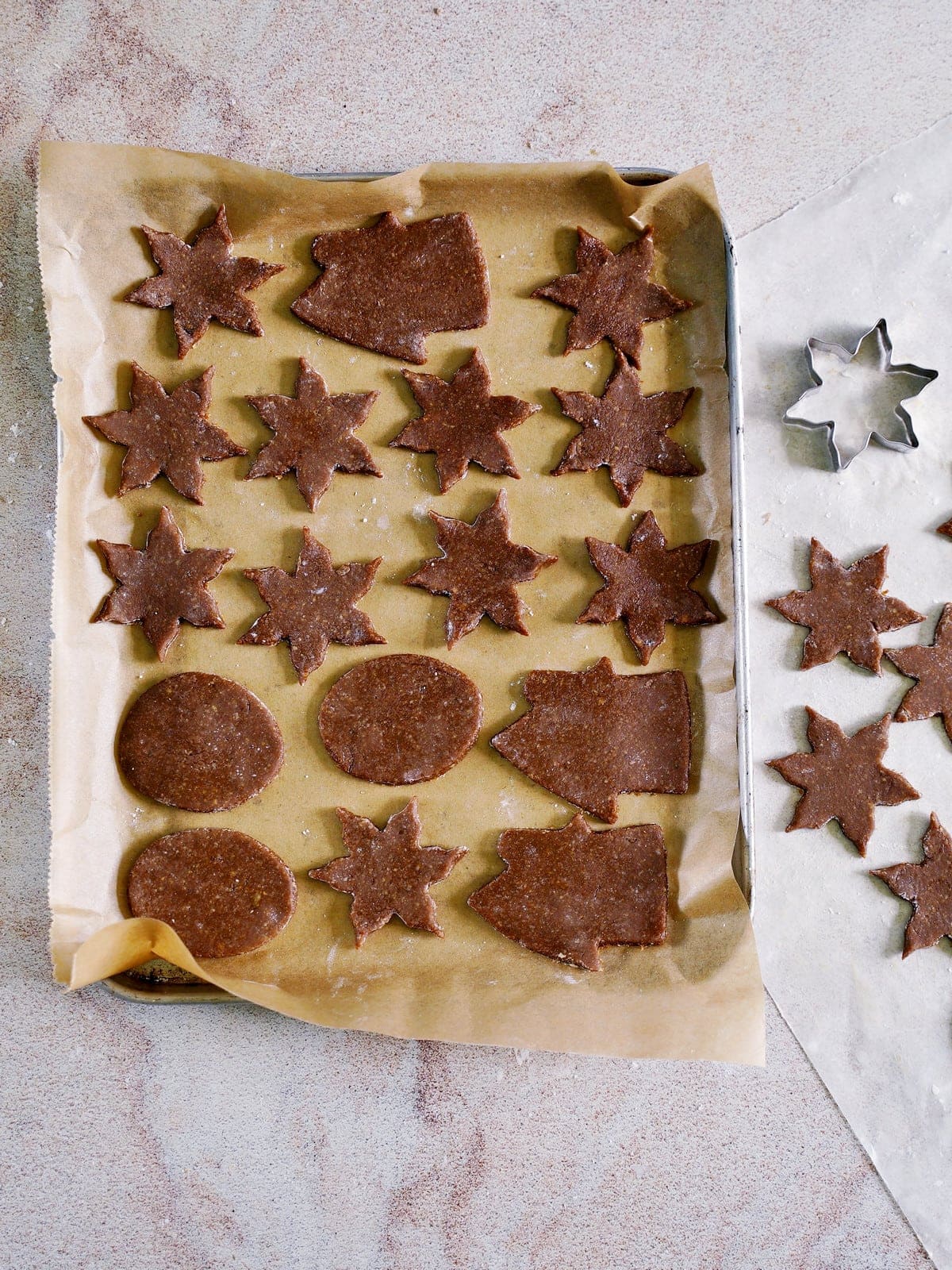
- Then bake in the oven for 8 minutes, until the edges are just beginning to brown. Then remove and allow to cool completely on a cooling rack before decorating.
The time will vary based on your oven and the size/thickness of the cookies, so adjust accordingly. If you prefer crisper vegan gingerbread, bake for an extra two minutes.
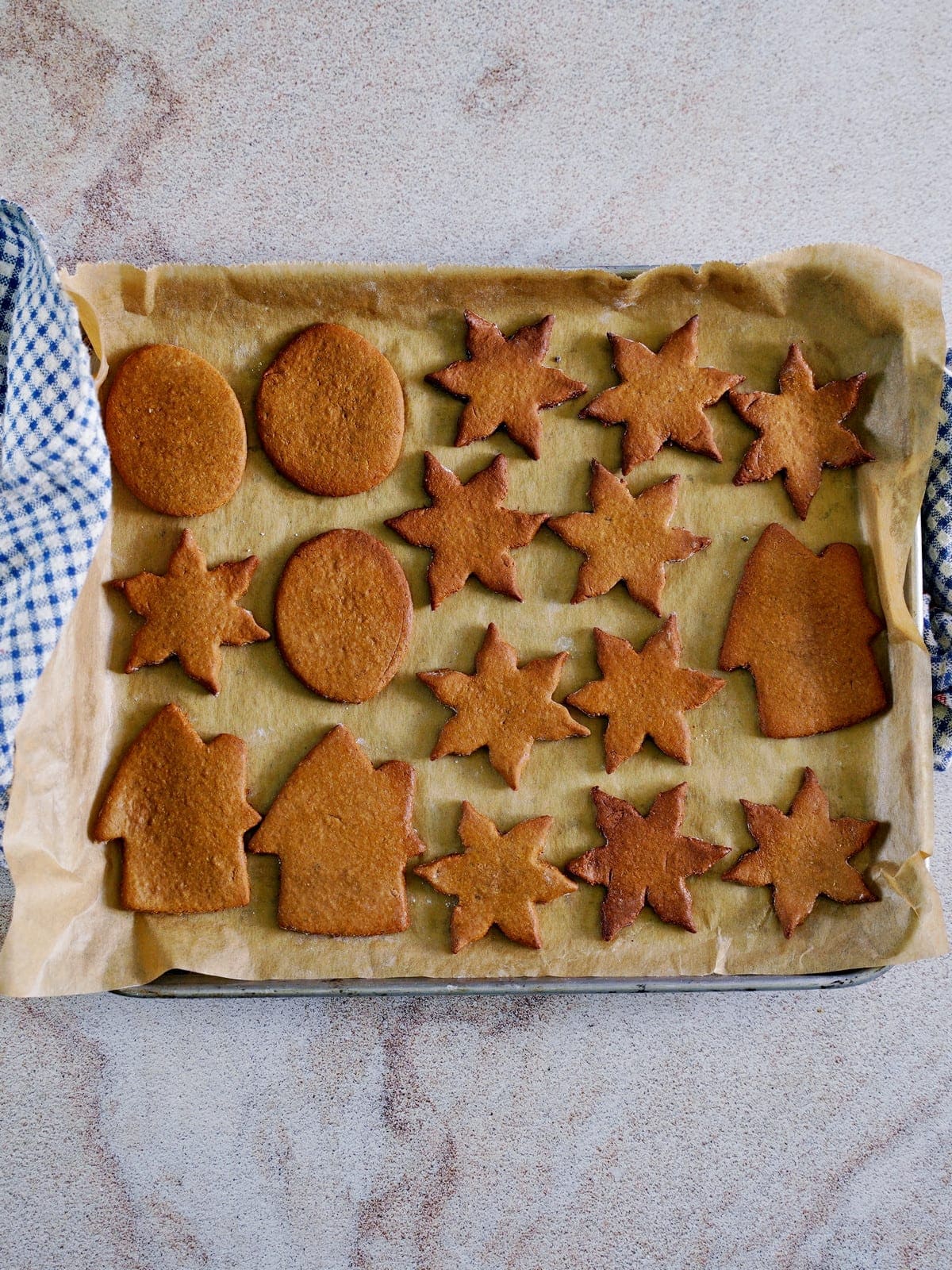
- Once the gluten-free gingerbread cookies have cooled, prepare the glaze by mixing the powdered sugar/Erythritol and water into a pipeable paste. Adjust the amount of water to get the correct consistency.
- Finally, decorate the vegan gingerbread cookies (refer to my next image to see how I did) and leave them to dry before enjoying them!

How to Store Gingerbread Cookies?
Make-ahead: You can prepare the paleo gingerbread cookie dough in advance and store it, tightly wrapped, in the refrigerator overnight. Leave it out on the counter for 5-10 minutes before continuing. You may also be able to freeze the dough, though I haven’t tried. Instead, I recommend freezing the un-decorated cookies and defrosting them in time to decorate and enjoy.
Store: Once the glaze has dried, store the vegan cookies in a cookie tin (it doesn’t need to be airtight as that can make the cookies softer faster) in a cool place for 2-3 weeks.
Freeze: I recommend storing the cookies before adding the glaze. Flash freeze on a baking tray before transferring to an airtight container/Ziplock bag and store for 4-6 months! Allow them to thaw at room temperature before optionally glazing and enjoying these paleo gingerbread cookies.

FAQs
How do you know when gingerbread cookies are done?
They should be JUST beginning to brown around the edges but still fairly soft (they crisp up further while cooling).
Why are my cookies dry?
This is likely because you’ve added too much flour to the dough. Make sure to use the metric measurements for best results.
What does molasses do for gingerbread cookies?
Not only does it give them the traditional gingerbread flavor, but it also helps to make these almond flour gingerbread cookies slightly softer.
Do almond flour gingerbread cookies taste like almond?
No, they actually don’t. With the combination of gingerbread spices and molasses, you’d barely be able to tell these are almond flour gingerbread cookies.

Recipe Notes and Top Tips
- Don’t skip chilling the dough: Or your gluten-free gingerbread biscuits might spread more in the oven and not hold their shape.
- If you don’t have piping bags: Use a small Ziplock bag and make a very tiny snip in the corner.
- Be careful not to overbake the cookies: They firm up more while cooling and will become overly hard if overbaked.
- To make your own powdered sugar/sweetener: Grind the granulated sugar/sweetener of your choice in a coffee/spice grinder into a powdered consistency. This will work will many types of granulated sugar/sweetener.
- To ship the cookies: First, store the cookies (best without the glaze) in a cellophane candy bag, Ziplock bag, or plastic wrap. Then place within a box/cookie tin, surrounded by padding. Then place that in your mailing box with more padding, tape up, and write FRAGILE on top of the box. I recommend posting them on the day they’re baked, too, so the recipient has a few days to eat them!

More Vegan Holiday Recipes
- Chocolate Salami (no bake)
- Homemade Marzipan
- Homemade Ferrero Rocher
- Vegan Cranberry Loaf
- Christmas Fruit Cake
If you try this easy vegan gingerbread cookie recipe, I’d love a comment and ★★★★★ recipe rating below. Also, please don’t forget to tag me in re-creations on Instagram or Facebook with @elavegan #elavegan—I love seeing them.

Vegan Gingerbread Cookies
Ingredients
- 1 3/4 cup (170 g) almond flour (see notes)
- 5 tbsp (40 g) tapioca flour (see notes)
- 1/3 cup (60 g) coconut sugar (I used powdered)
- 3/4 tbsp ground cinnamon
- 3/4 tbsp ground ginger
- 1/4 tsp ground nutmeg
- 1/4 tsp ground cloves
- 1/2 tsp baking powder
- 1/4 tsp salt
- 2 tbsp (40 g) molasses
- 2 tbsp (30 g) coconut oil
- 2-4 tbsp cold water
Glaze
- 7-8 tbsp (70 g) powdered Erythritol or icing sugar
- About 1 tbsp water or less/more, depending on which sugar you use
Instructions
- You can watch the video in the post for visual instructions.I recommend using the metric measurements. Add all dry ingredients to a bowl and mix with a spoon.
- Pour in the wet ingredients (starting with 1 tbsp cold water) and mix again, then knead with your hands until a dough forms. If the dough is too dry, add more water (or coconut oil), 1 tsp at a time. If it's too wet, add more flour.
- Wrap the dough into cling film and chill it in the fridge for 20-30 minutes.
- Place the chilled dough between 2 layers of wax paper (or parchment paper) and roll it out with a rolling pin. It should be about 0.6-0.7 cm thick (1/4 inch).
- Preheat the oven to 350 degrees Fahrenheit (175 degrees Celsius) and line a baking sheet with parchment paper. Use your favorite cookie cutters to cut out the cookies. You can dip your cutter in a bowl of powdered sugar (or tapioca flour) between cutting the cookies. This will help prevent the dough from sticking to the cutter.
- Transfer them to the prepared baking sheet and bake in the oven for 8 minutes. Depending on the thickness of your cookies, the baking time may vary by a few minutes. Let them cool completely.
- Meanwhile, make the glaze by mixing icing sugar (I used powdered Erythritol) and water in a small bowl until it's a creamy paste. If it's too thick add a little more water and if it's too thin add more icing sugar. Decorate the cooled cookies and let them dry. Enjoy! Store cookies in a cookie tin in a cool place for up to 2-3 weeks.
Notes
- Almond flour (ground almonds): You can use any other finely ground nuts or seeds of choice.
- Tapioca flour: Any other starch will probably work too.
Nutrition information is an estimate and has been calculated automatically
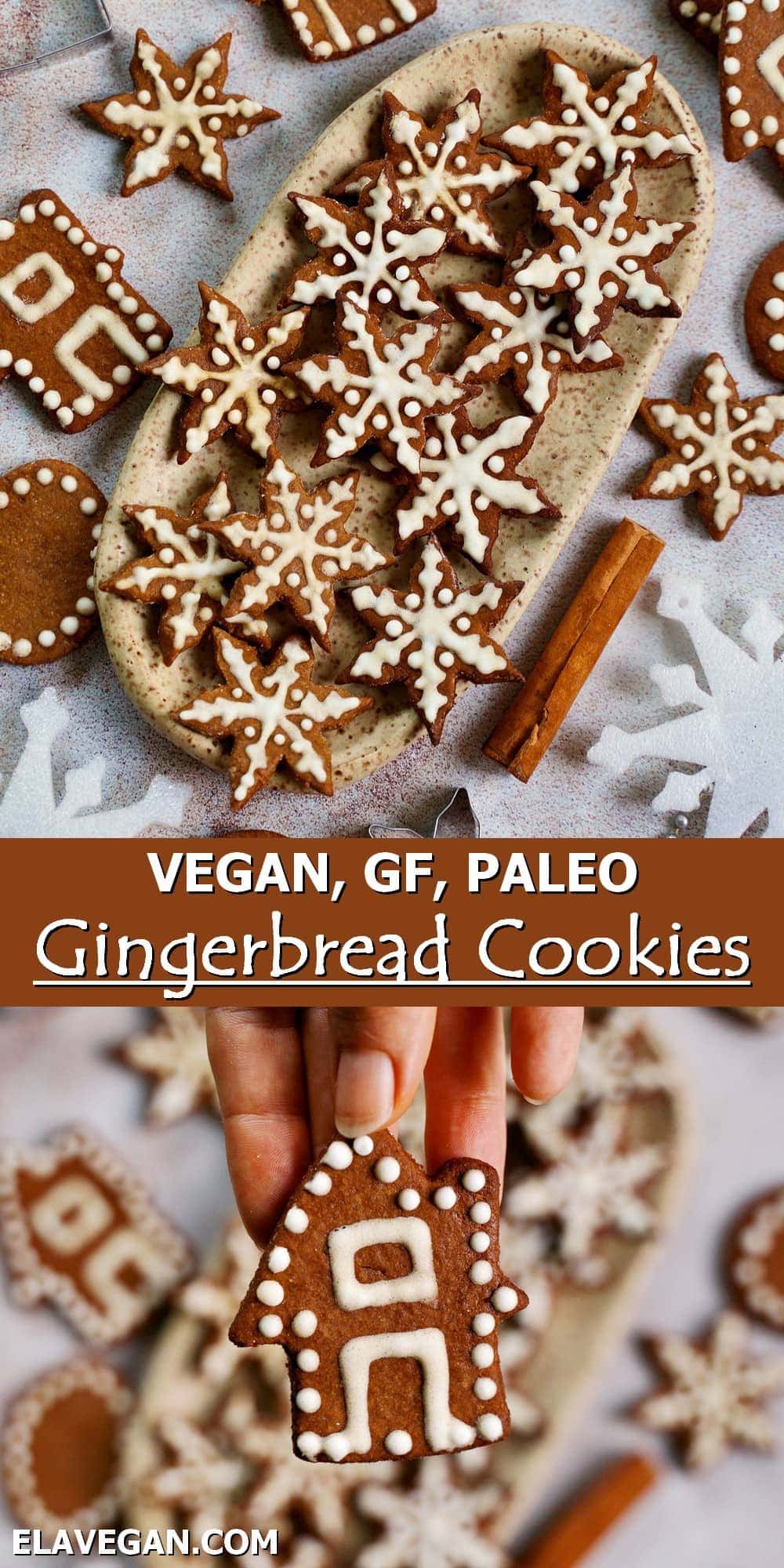

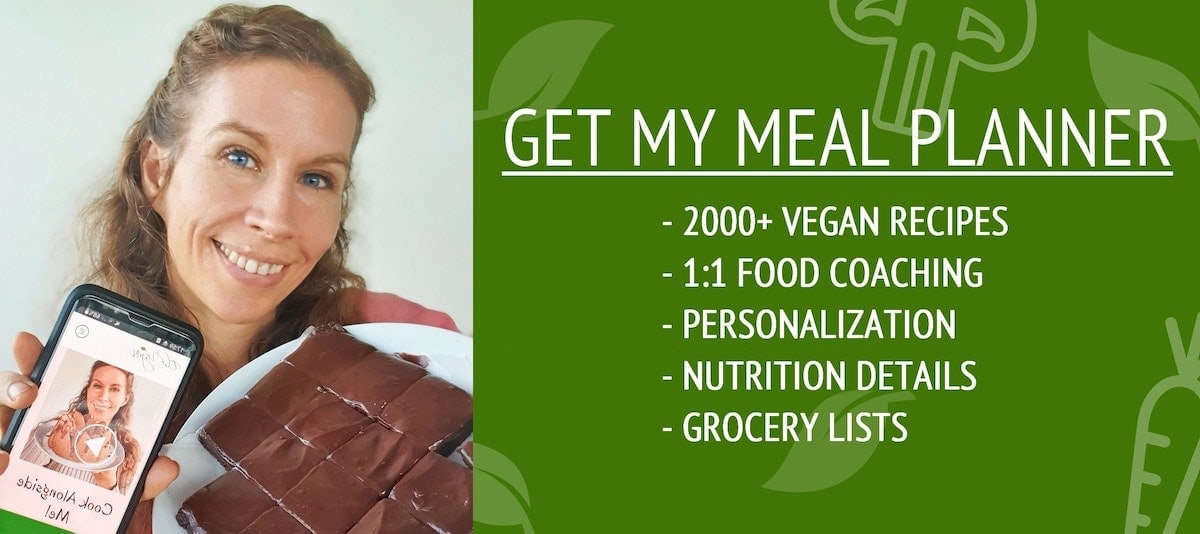

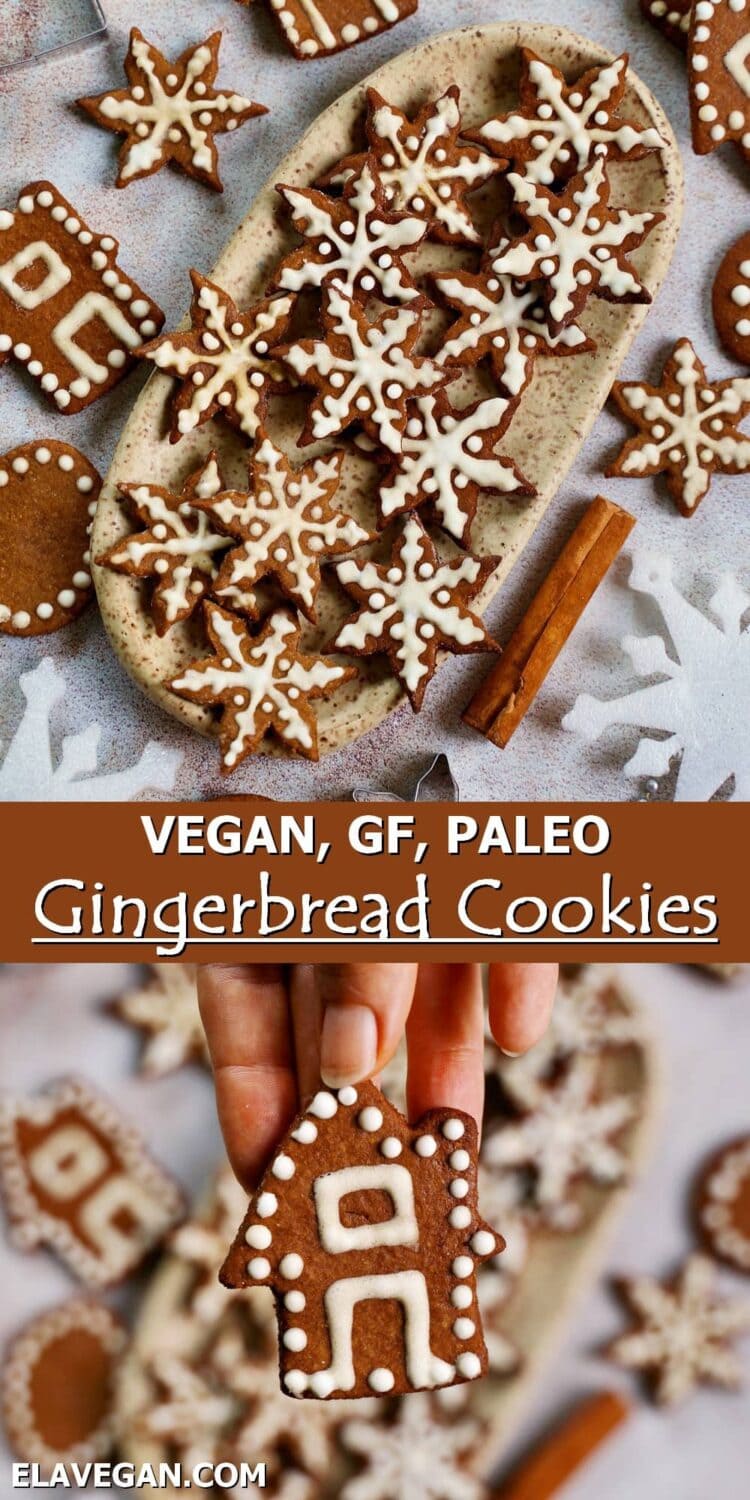
Best cookies ever! 🥰
Even slightly changing something it always works and they get yummier and yummier 🤗
Thanks for inspiration!
Aww, that’s awesome, Sanrio! So happy to hear that. 🙂
Just made these and they are delicious!!! Such a nice flavour and crunch but not dry at all 😍 thank you for your recipes! I didn’t have molasses so used almond butter instead and it turned out amazing!
So happy to hear that, Camille! Thanks for your feedback. 🙂
Hi Ela, I tried the recipe, and I struggled with the dough – it was even too oily or too dry. I kept the recipe with the amount of the coconut oil, but when I formed the dough, it seemed too oily – so I was adding the almond flour bit by bit still seemed oily enough but then it turned into the dry dough, and it did not keep formed… so I added a tbsp of cold water but ended with a similar result – weirdly oily dough 🙁 What am I doing wrong?
Thanks a lot for your advice 🙂
Hi Lucie, I am not 100% sure what went wrong. But it sounds that you did knead the dough for too long, so the oil separated?
Oh, I see, I will give it a try once again. I melted the coconut oil because it was at a lower temperature and was not liquid, so maybe it was also the issue. I will try it once again without melting the coconut oil and knead it for a shorter time.
Thanks for so quick response Ela 🙂
You are very welcome, dear! 🙂
Hello Ela
I’m very excited to try your gingerbread cooked recipe,
But I have a question, can I replace the almond flour with oats flour?
Or just the whole wheat flour?
Hello Lisa, no, that’s not possible. You need the fat from the ground almonds, however, you can use any other ground nuts or seeds of choice. 🙂
Is there a recommended sub for almond flour if there are food sensitivities to almond?
Hi Tricia, finely ground sunflower seeds or hazelnuts might work as well. 🙂
Hi Ela – do you think this recipe would be suitable for making a gingerbread house? We have a kit to cut out the house shapes but need a gf / vegan recipe 🙂
Hi Cathy, it might work, but I haven’t tried it. 🙂
Ok thank you 🙂
So yummy and cooked beautifully! I used coconut flour to help with stickiness when rolling and cutting. Made our house smell amazing too!
That’s awesome, Courtney! I am so glad you liked them. 🙂
Hi Ela! I’m not going to rate the recipe as I don’t want to be unfair, but I just made this recipe to a T a the cookies lost their shape..
Of course I chilled the dough, I even put the cut dough in the freezer for 5 minutes for extra precaution.
I really don’t understand (although it also happens with another one of your Christmas cookie recipe) but I noticed you wrote baking soda in the recipe but baking powder in the picture.
Which one should we use and could it be the reason why? I used baking soda.
Thank you for your help!
Hi Eva, thanks so much for letting me know about the mistake. It’s actually baking powder! I just fixed it in the recipe.
Just yesterday, someone on YouTube commented that these were the best gingerbread cookies the person made. I hope you still liked them! 🙂
Thank you Ela! I though that might be the problem here!
I’ll try again with baking powder, but no worries you’re a great vegan & healthy recipe-maker no doubt 😉 Happy holidays!
Thanks so much, Eva! Happy holidays to you and your family. 🙂
Hello Ela,
Can I replace molases with something else. I don’t get it here.
Thank you!
Hi Ulrike, as I wrote in the post, you could use more maple syrup instead, but then the cookies won’t have the gingerbread flavor. 🙂
I was reading the reviews and comments with my Husband. To the gal who didn’t have molasses my husband wondered if she could use burnt sugar? Sounded like a great idea although still not molasses but might give some needed flavor. Thoughts?
Sounds interesting, Susan, though molasses is less sweet. But, it could be worth trying. 🙂
Hello, Ela. Thanks for receip. Could you tell me please, may I use honey instead molasses?
Yes, but the result will be definitely different.